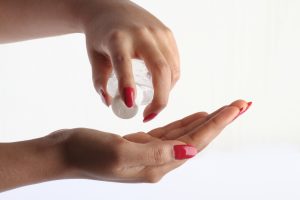
Clean hands is an obsession for some people. In addition to frequent hand-washing, many people also use alcohol-based hand sanitizers. Aside from the potential issues with dry skin and weakened immune system (not to mention OCD!), use of hand sanitizers can also affect the results of a breath alcohol test.
The impact of hand sanitizers on breath testing was the subject of a recent article in the Journal Of Forensic Sciences. A previous study concluded the absorption of alcohol from hand sanitizers has virtually no effect on blood alcohol concentration. The current study answered a different question: what if the hand sanitizer is on the hands of the breath test operator?
To answer the question, the researchers had breath test operators apply hand sanitizer, rub their hands until dry, and then administer breath tests to subjects who had consumed no alcohol. Part of administering the breath test is removing the disposable mouthpiece from its package and inserting it in the breath tube for the test.
The results showed over 40% of the tests resulted in a false positive breath alcohol concentration or a status code from the breath-testing machine. The alcohol vapor from the hand sanitizer made its way through the breath tube into the sample chamber where the subject’s breath sample was analyzed. Of the 130 samples, about 10% were false positives, and about 32% were flagged by the machine as ‘mouth alcohol’.
Mouth alcohol is a problem in breath testing. The machine is supposed to detect alcohol in breath from the subject’s lungs. If there is alcohol in the subject’s mouth, it can be added to the alcohol in the lung breath and falsely elevate the alcohol concentration. Breath-testing machines are designed to detect mouth alcohol using a software algorithm, but the mouth alcohol detection in the machines is less than perfect.
Although hand sanitizer is not mouth alcohol, it has the same effect. Alcohol from the sanitizer is added to alcohol from the subject’s breath to falsely elevate the test result. While the breath-testing machine flagged 32% of the samples contaminated with sanitizer, there could still be a problem.
In the real world, a status code from mouth alcohol will result in a second breath test. In the second test, the alcohol from the hand sanitizer may be decreased enough to avoid triggering the mouth alcohol detector but still be added to the subject’s breath alcohol concentration.
Alternatively, the second test may also result in a status code for mouth alcohol. The typical status code is “invalid sample”. In most cases, if a subject produces two invalid samples, the officer considers the circumstances to be a refusal of the breath test. The subject is then given an Administrative License Suspension for at least one year, with no driving privileges for at least 30 days. This could happen, even though the invalid samples were caused by hand sanitizer.
I have visited the breath-testing rooms of several law enforcement agencies, and many of them have hand sanitizer in the room. I’m sure officers sometimes feel a need to sanitize, but doing it before a breath test is a problem. The problem could easily be avoided by law enforcement agencies removing the hand sanitizer and implementing procedures prohibiting its use (by the officers and the subjects) for 30 minutes before the breath test.
If you’re a doctor performing a surgery, please sanitize beforehand. If you are a police officer administering a breath test, please sanitize afterward.
 Columbus OVI/DUI Attorney Blog
Columbus OVI/DUI Attorney Blog

